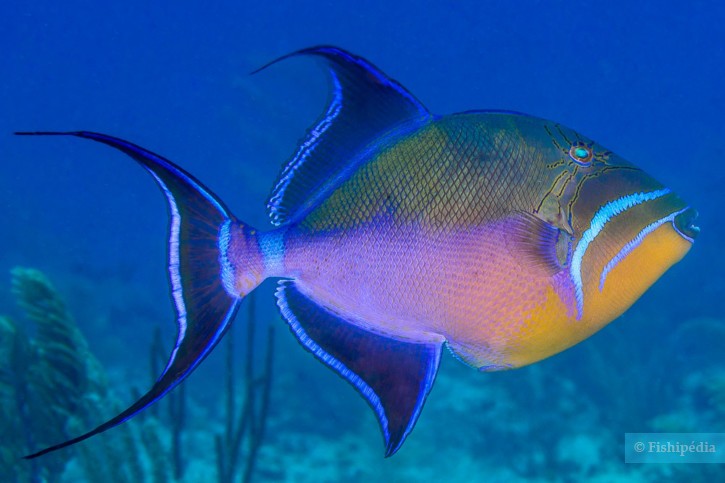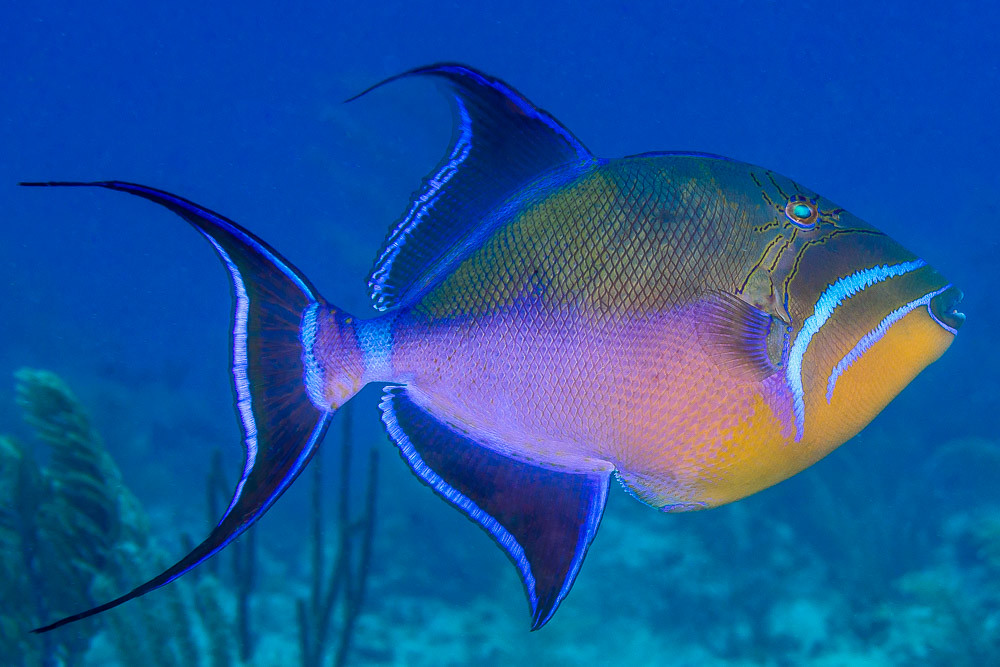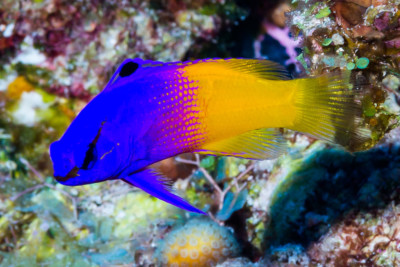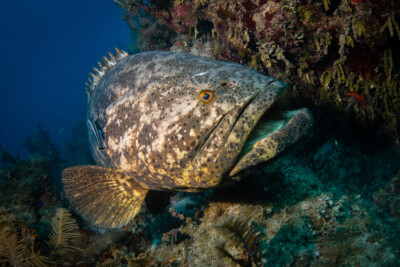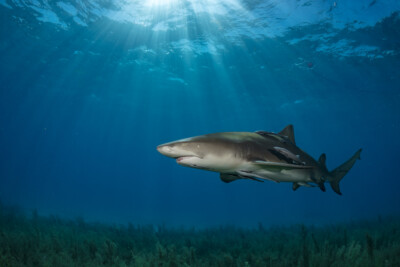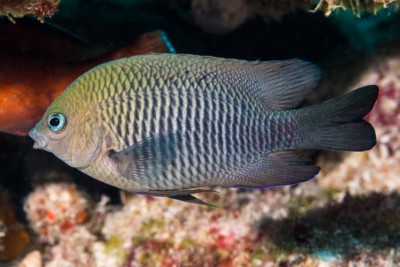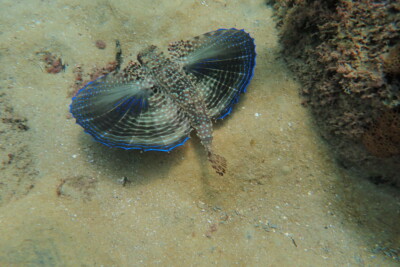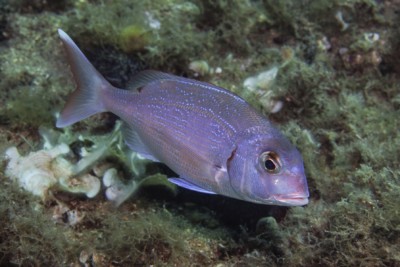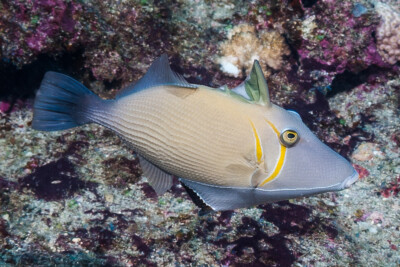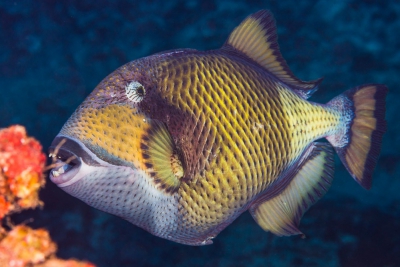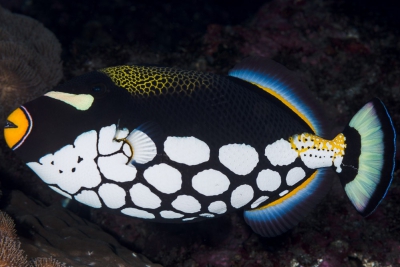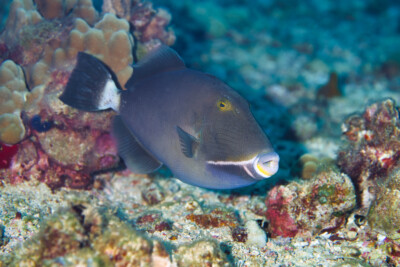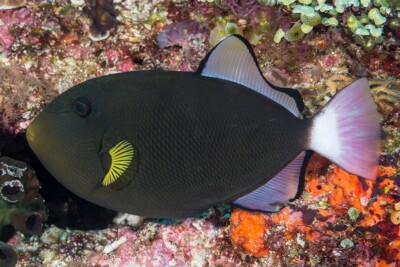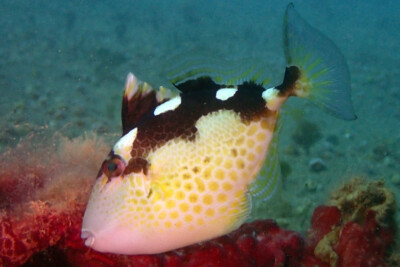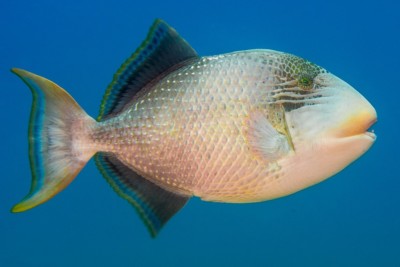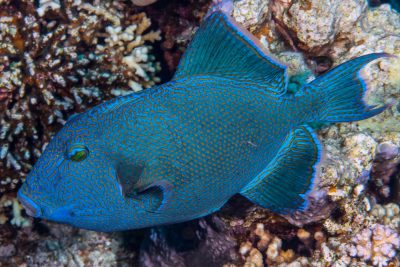Introduction
The Balistes vetula, more commonly known as the queen triggerfish, is a fish living in the tropical and temperate waters of the Atlantic Ocean. On the east side, it is found from Florida to Rio de Janeiro. On the west side, it is present from Cape Verde to the south of Angola.
Since 2011, the queen triggerfish has been considered nearly threatened by the IUCN. Its populations continue to decline today. The main threat is accidental capture in industrial fishing nets. However, it is sometimes sought after for its flesh, especially on African and South American coasts. Conservation of the species aside, it is recommended not to consume this species as its liver can cause severe food poisoning.
Who is it?
Morphology
-
Type
-
Average size24 cm
-
Maximum size60 cm
-
ShapeOval
-
Patterndiagonal stripes
-
Type
-
Average size24 cm
-
Maximum size60 cm
-
ShapeOval
-
Patterndiagonal stripes
How to recognize This fish ?
The queen triggerfish can measure up to 60 centimeters. The body is laterally compressed, covered with large scales. Its coloration varies depending on the zone and age. It is mainly gray-green or bluish on the back, and yellow-orange on the lower part of the head and belly. This coloration can be darker depending on the fish's mood. A broad blue bar is located on the caudal peduncle.
This species is easily identifiable by the two bright blue diagonal bands on the head. These start from the snout and end below the pectoral fins. The one closest to the mouth ends with a ring around the lips. This emphasis on the patterns gives this fish a larger appearance.
The eyes are located high on the head, they are independent of each other. The mouth is small compared to the head size.
Like other triggerfish, this species has three dorsal fins, the first is long and pointed and formed by three spiny rays. The first ray can be locked in a vertical position while the second secures it. This mechanism is used as a deterrent for predators. It can also be used to find refuge in a cavity. Once inside, the triggerfish unfolds its fin to cling and protect itself from currents.
Sexual dimorphism
The difference between male and female is hardly noticeable.
Behaviour & Life cycle
-
dietcarnivorous
-
Sociabilityliving in a group or alone
-
territorialNo
-
Way of livingdiurnal
The queen triggerfish is generally encountered in schools in coral reefs. However, it is possible to encounter it alone or in smaller groups near sand or seagrass.
It is a species with a rather calm temperament. Although this fish is non-territorial strictly speaking, it is sometimes aggressive towards other species, especially during the breeding season.
It primarily feeds on benthic invertebrates such as echinoderms, crustaceans, mollusks, and occasionally other species of small fish. Sometimes it feeds on sea urchins by blowing water to overturn them and then attacks where the spines are short.
Reproduction
-
Reproductionovovivipare
The Queen triggerfish is an ovoviviparous fish. The male digs a nest in the sand with its fins and jets of water blown from its mouth. Once the cavity is created, the female lays her eggs. The couple protects the spawn until hatching.
The juveniles of this species are pelagic, they remain at the surface, camouflaged in algae.
Risks for humans
-
VenomousNo
-
BiteYes
Triggerfish are temperamental fish, especially during the breeding season. It does not hesitate to attack bathers who approach their nest. Unlike weevers, rays, and scorpionfish, this fish is not venomous and sticks to small bites, like large piranhas. It is less virulent than its tropical cousin, the titan triggerfish.
Bites and small hits are harmless to bathers, but can be problematic during dives. Indeed, triggerfish have been known to break the masks of experienced divers at significant depths.
Moreover, triggerfish defend a conical territory from their nest, vertically. Thus, going directly above a nest does not stop the triggerfish in its attack. It is necessary, on the contrary, to move away to the side.
Origin and distribution
Geographic distribution & Conservation
No text specifying distribution and conservation
Conservation status of populations (IUCN)
What is its habitat?
Natural environment characteristics
-
Temperature23 - 28 °C
-
Depth2 - 275 m
Biotope presentation
The Queen triggerfish is most commonly found in coral reefs at a depth of less than 275 meters. However, it is more common in coral areas and lagoons.
Species of the same biotope
To go further
Sources & Contributions
Participation & Validation
The Fishipedia team and specialist contributors are committed to providing high-quality content. However, although the information comes from scientific sources or testimonials from specialists, the cards may contain inaccuracies.

Silvia Gomez

Benoit Chartrer
Translation
Translation done with the valuable contribution of our translators, who make this information available to a wider audience. We sincerely thank them for their commitment.
Bibliographic references
- - GBIF
- - Growth, mortality and exploitation rates of the Queen Triggerfish Balistes vetula in the Brazilian East Coast - Ricardo FREITAS NETTO & Ana Paula MADEIRA - - 2010.
- - AGE AND GROWTH OF THE QUEEN TRIGGERFISH Balistes vetula (TETRAODONTIFORMES, BALISTIDAE) OF THE CENTRAL COAST OF BRAZIL - Cristiano Queiroz de Albuquerque, Agnaldo Silva Martins , Nilamon de Oliveira Leite Junior , Julio Neves de Araújo and Alan Marques Ribeiro - - 2011.
Scientific partners
Tags
Species of the same family
Species of the same biotope
